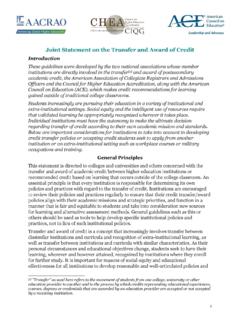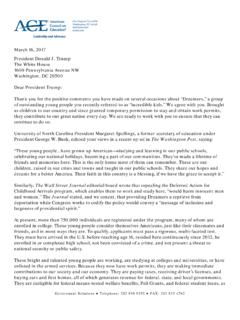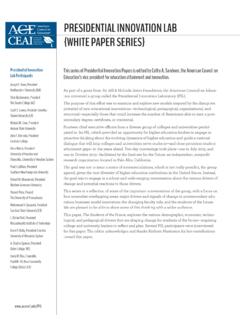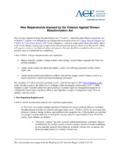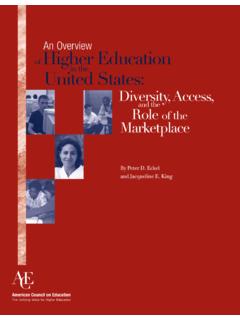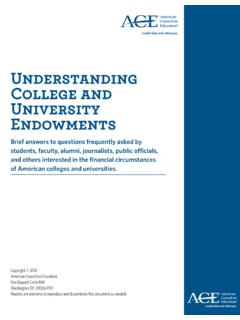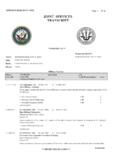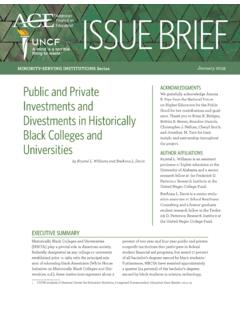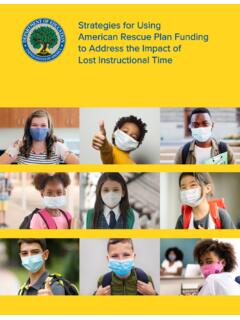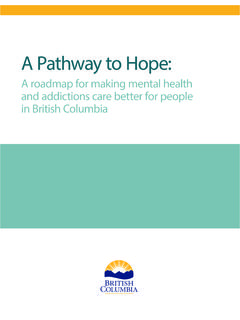Transcription of MENTAL HEALTH, HIGHER EDUCATION, AND COVID-19
1 PREPARED BY: Active Minds, American College Health Association, American Council on Education, Healthy Minds Network, JED Foundation, Mary Christie Foundation, and The Steve FundMENTAL HEALTH, strategies for Leaders to Support Campus Well-BeingAmericanCouncil on EducationAND COVID-19 HIGHER EDUCATION, ACE and the American Council on Education are registered marks of the American Council on Education and may not be used or reproduced without the express written permission of Council on EducationOne Dupont Circle NWWashington, DC 20036 2020. All rights reserved. No part of this publication may be reproduced or transmitted in any form or by any means electronic or mechanical, including photocopying, recording, or by any information storage and retrieval system, without permission in writing from the on EducationCONTRIBUTORSA mericanCouncil on Education1 | American Council on EducationINTRODUCTIONH igher education s response to the COVID-19 pandemic rests largely on its executive leaders, whose varying responses to the crisis will make an imprint on their institutions for years to come.
2 This is particularly true of their response to student MENTAL health, an issue that was already top of mind for presidents before the crisis imposed a new level of anxiety and isolation. As leadership teams move to address student MENTAL health during the pandemic, this brief provides high-level considerations for both short- and long-term planning. According to recent surveys of college presidents conducted by Inside HIGHER Ed, over 90 percent reported being very or somewhat concerned about student MENTAL health during the COVID-19 crisis, making it their top concern (Lederman 2020). The data likely reflects presidents fears about how the disruption and uncer-tainty of school closings and distance learning will affect students already-rising rates of anxiety and depres-sion. It also reflects just how aware presidents are of the impact of student MENTAL health on a range of HIGHER education outcomes from well-being and readiness to retention and completion.
3 In a 2019 Pulse Point survey conducted by the American Council on Education (ACE), eight out of 10 presidents indicated that student MENTAL health had become more of a priority on their campus than it was three years ago (Chessman and Taylor 2019). ACE s April 2020 Pulse Point survey of college and university presidents responding to COVID-19 suggested that a little over a third of presidents surveyed plan on making more investments in student MENTAL health due to COVID-19 (Turk, Soler, and Vigil 2020). As leaders deploy time and resources to what they have identified as a major priority, a number of questions can be considered: What are students telling us they need now, in addition to when they return to school? How will decisions of HIGHER education leaders affect MENTAL health service delivery as well as prevention and wellness? Are leaders responding to the MENTAL health needs of faculty and staff?
4 And are institutional strategies considering the needs of diverse student populations? As we see across the country, the COVID-19 Kent State University** David Wilson (CC BY ) MENTAL Health, HIGHER Education, and COVID-19 | 2pandemic is not affecting students equally. It appears likely to exacerbate the unique MENTAL health issues faced by students of color, LGBTQ+ students, and low-income students. Using both new and existing data, authors of this brief have identified three major categories for leaders to consider in responding to student MENTAL health during COVID-19 and beyond: communication; the MENTAL health and well-being of all campus stakeholders; and the need for assessment elements that are critical to planning at any time, and particularly now. Authors offer examples and resources to help guide decision-mak-ing, including ways that leadership can adopt an equity lens to each of these MENTAL health considerations.
5 ENSURE THAT COMMUNICATION TO STUDENTS IS CONSISTENT, CARING, AND students report a lack of regular and compassionate communication from their institutions as a primary stressor during COVID-19 , according to a nationwide survey (Active Minds 2020). Not only do students report uncertainty about academic options and what those options mean for their future, but more than half say that they do not know where to turn for MENTAL health support. This lack of clarity is concerning since one in five students report that COVID-19 has significantly worsened their MENTAL health. Overall, students seek compassionate, caring communications that acknowledge the burdens they may face, including caring for family members, suffering financial setbacks, or having trouble accessing or staying focused during lectures. As a first step, leadership can recommend that faculty check in with students and provide reasonable flexibility and accommodations, similar to guidance from the University of Texas at Austin.
6 These check-ins help students maintain a sense of belonging, and communicate that their institution cares for their holistic particular, leaders should seek out communication channels for underrepresented populations, who face greater stigma about seeking assistance, especially MENTAL health support. Particularly now, leaders need to be aware of the emotional impact of the pandemic on students of color given the health disparities in African American and Latinx communities, as well as xenophobia and bias-motivated attacks on Asians and Asian Americans. Montclair State University, for example, moved its in-person Let s Talk student drop-in hours to an online format and is hosting virtual support groups for women of color (a mix of students, faculty, and staff). Similarly, Colorado College created an information sheet for faculty and staff to assist international students.
7 Campus partners who work directly with students cultural and identity centers, faculty or aca-demic advisors likely have the ability to gather data on their needs quickly. These populations can often fall through the cracks of larger, campus-wide efforts. From an academic standpoint, Boston University, Denison University, University of Richmond, and others are providing alternative, personalized grading options, allowing students to select a credit/no credit or pass/fail grade in lieu of letter grades. The schools communicated those options to students and parents/guardians 3 | American Council on Educationoften and through multiple channels. At the same time, be sure to offer guidance regarding how these options may impact students future educational or career addition to communicating academic guidelines, many institutions are sharing powerful messages with stu-dents regarding overall wellness.
8 Leading institutions in student well-being, such as California State University Long Beach and Denison University, send regular video messages from their top leaders, encouraging students to communicate with faculty about how things are going and what they need. In these examples, seeing and hearing a person cuts through the considerable amount of email and helps convey compassion and under-standing (Horne 2020). Kent State University, another recognized leader in student wellness, created a one-stop shop website, call line, and email address for all COVID-19 questions, including telehealth and telemedicine information. More institutions should follow its lead in ensuring COVID-19 resource hubs prominently place wellness services ( , telehealth resources, insurance guidance, crisis resources, and grief counseling) so students can find them. It is also helpful to include tailored support or guidance for students in unique situations, such as students living alone or in negative or unsafe living ahead, consider not only a greater investment in MENTAL health as a result of COVID-19 , but also how to communicate that commitment to students.
9 They want to know their campus is planning for the MENTAL health support they will need when they return and that the campus will establish new practices and protocols in the event of a future crisis. Many students will look for a campus ready and willing to walk with them through the necessary healing and recovery, moving forward together as a community. Miami University** Jim Pater (CC BY-NC-ND ) MENTAL Health, HIGHER Education, and COVID-19 | 4 CONSIDER THE MENTAL HEALTH AND WELL-BEING OF ALL CAMPUS COMMUNITY and staff are on the front lines of serving and supporting students, leading the charge during these uncharted times. Supporting them is one of the most effective ways leaders can support students. Eighty percent of surveyed faculty and staff believe that it is very or extremely important to model positive health and wellness behavior to students (American College Health Association 2020).
10 Many are trying to keep a sense of normalcy despite experiencing their own uncertainties, fears, and anxieties. They, too, are quickly adapting to new ways to do business, juggling work-life balance, and addressing the new and varying academic and student life issues. To support faculty and staff well-being, leaders should consider realigning expectations for productivity and increasing flexibility. Adjusting timelines for tenure, reappointment, and the evaluation and promotion pro-cess may mitigate some of the stress and anxiety as faculty negotiate the balance of work and life. Additionally, keep in mind that all community members could benefit from services and support that address food insecurity or other emergencies. Non-tenure-track instructors, part-time faculty members, and early- career professionals likely have layered commitments ( , multiple jobs), and any campus member could be experiencing an income shortfall as a result of a partner or family member losing their job.

